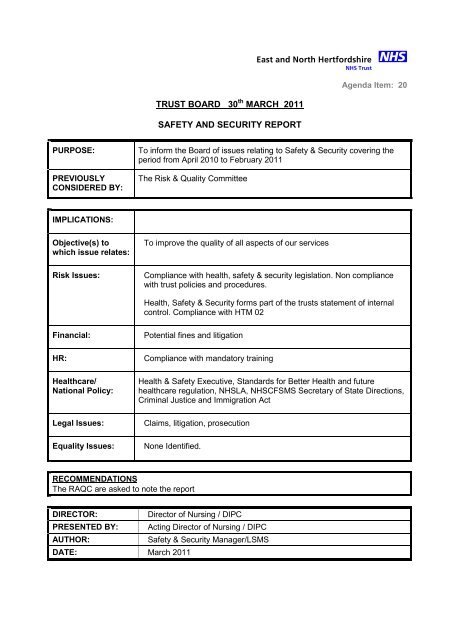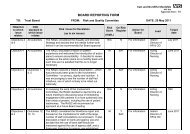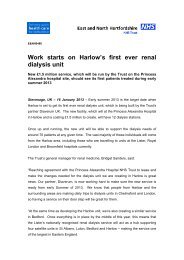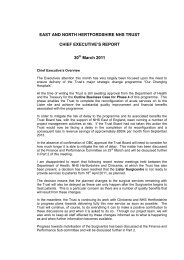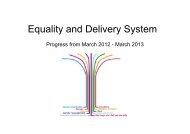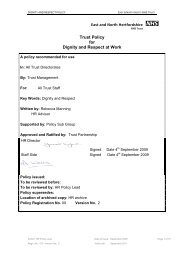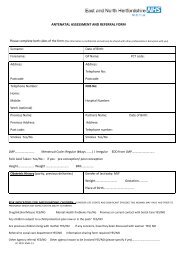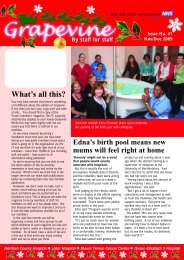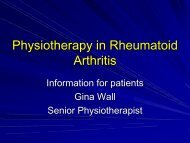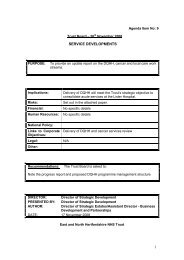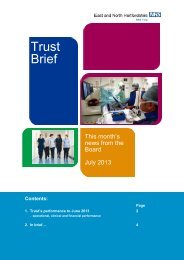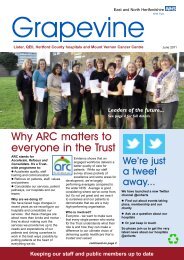Safety & security report - East and North Herts NHS Trust
Safety & security report - East and North Herts NHS Trust
Safety & security report - East and North Herts NHS Trust
You also want an ePaper? Increase the reach of your titles
YUMPU automatically turns print PDFs into web optimized ePapers that Google loves.
defAgenda Item: 20TRUST BOARD 30 th MARCH 2011SAFETY AND SECURITY REPORTPURPOSE:PREVIOUSLYCONSIDERED BY:To inform the Board of issues relating to <strong>Safety</strong> & Security covering theperiod from April 2010 to February 2011The Risk & Quality CommitteeIMPLICATIONS:Objective(s) towhich issue relates:To improve the quality of all aspects of our servicesRisk Issues:Compliance with health, safety & <strong>security</strong> legislation. Non compliancewith trust policies <strong>and</strong> procedures.Health, <strong>Safety</strong> & Security forms part of the trusts statement of internalcontrol. Compliance with HTM 02Financial:HR:Healthcare/National Policy:Legal Issues:Equality Issues:Potential fines <strong>and</strong> litigationCompliance with m<strong>and</strong>atory trainingHealth & <strong>Safety</strong> Executive, St<strong>and</strong>ards for Better Health <strong>and</strong> futurehealthcare regulation, <strong>NHS</strong>LA, <strong>NHS</strong>CFSMS Secretary of State Directions,Criminal Justice <strong>and</strong> Immigration ActClaims, litigation, prosecutionNone Identified.RECOMMENDATIONSThe RAQC are asked to note the <strong>report</strong>DIRECTOR:Director of Nursing / DIPCPRESENTED BY: Acting Director of Nursing / DIPCAUTHOR:<strong>Safety</strong> & Security Manager/LSMSDATE: March 2011
BackgroundGood safety <strong>and</strong> <strong>security</strong> management is essential in order to deliver an environment for thoseto work in or use the <strong>Trust</strong> that is properly secure <strong>and</strong> safe so that the highest st<strong>and</strong>ard ofclinical care can be made available to patients.AssuranceThe information provided indicates the focus of management activity that the Board would wishto be aware of <strong>and</strong> assists in the process of giving safety & <strong>security</strong> assurance to the Board.Health, <strong>Safety</strong> & Security Management is required to provide assurance for the following:Health & <strong>Safety</strong> Executive, Care Quality Commission, <strong>NHS</strong>LA, Environment Agency, Secretaryof State Directions (<strong>NHS</strong>CFSMS).Following the recent change in executive director accountability, this <strong>report</strong> will provide a briefoverview of the current position <strong>and</strong> outline the subjects that will be <strong>report</strong>ed in more detail infuture quarterly <strong>report</strong>s.The <strong>Trust</strong> has a duty of care to staff, patients <strong>and</strong> visitors <strong>and</strong> is required to comply with anumber of Health <strong>and</strong> <strong>Safety</strong> Regulations.Key challenges;Failure to comply with trust policies <strong>and</strong> procedures represents a risk to the trust.Action; The trust provides corporate health & safety polices <strong>and</strong> procedures to all departmentsin a <strong>Safety</strong> & Security Red file. Each department is required to complete departmental riskassessments <strong>and</strong> file these in the departmental risk assessment file. These files are auditedannually by the Health & <strong>Safety</strong> Advisor. The results of the 2010 audit are shown below:198 red files audited;125 80% compliant or above65 70%-79% compliant9 below 70%.complianceThese 9 departments have action plans in place <strong>and</strong> are receiving support to further improvetheir score to achieve compliance.The <strong>Safety</strong> & Security Red files are also audited by the trusts auditors RSM Tenon; all actionsrequired from their last audit have been completed.Many incidents are un<strong>report</strong>ed which makes accurate analysis difficultAction; The team liaises with Risk Management <strong>and</strong> the Police <strong>and</strong> uses training events tohighlight the importance of <strong>report</strong>ing. all thefts of property <strong>report</strong>ed to Police.A poor <strong>security</strong> culture increases the incidence of theft of both personal <strong>and</strong> trustpropertyAction; Ensuring better partnership working with community safety partnership <strong>and</strong> the localneighbourhood policing teams. A number of <strong>security</strong> audits have been undertaken with supportfrom Hertfordshire Constabulary.RIDDOR <strong>report</strong>able incidents are frequently outside the required 10 day deadline
Action; All RIDDOR <strong>report</strong>able incidents have been investigated to ensure lessons have beenlearnt <strong>and</strong> appropriate measures are in place. All late RIDDOR submissions have beeninvestigated to ensure all staff are aware of the type of incidents that must be <strong>report</strong>ed. Aregular review of all Datix entries is undertaken to identify possible RIDDOR <strong>report</strong>ableincidents, this allows for early contact with managers to establish if an F2508 is required.The existing manned guarding contract is no longer fit for purpose.The trust is unable to implement the powers of the Criminal Justice <strong>and</strong> ImmigrationAct or implement a full site lockdown.CCTV is out dated <strong>and</strong> unable to provide evidential quality images to assist in theprosecution of offendersAction: The existing <strong>security</strong> contract has been in place for a number of years. The contracthas been managed by the General Services Manager up until January 2011. The contract isnow managed by the <strong>Safety</strong> <strong>and</strong> Security Department. A review of the existing arrangementshas been undertaken but no decision made. The Director of Nursing has agreed to revisit thiscontract. There needs to be consideration in respect of increasing the number of hours that<strong>security</strong> officers are on site <strong>and</strong> the skills of those officers. The current contract covers nights<strong>and</strong> weekends only. Day time incidents are managed by trust staff which potentially puts theseuntrained staff at risk. Existing <strong>security</strong> officers are not trained in control <strong>and</strong> restraint. Havingofficers trained in control <strong>and</strong> restraint available 24 hours a day would improve the safety <strong>and</strong><strong>security</strong> of all staff, patients <strong>and</strong> visitors <strong>and</strong> improve the trusts ability to secure <strong>and</strong> lockdownthe site should the need arise, an action required to be taken to implement the powers of theCriminal Justice <strong>and</strong> Immigration Act.Senior nursing staff have recently drafted a policy on control <strong>and</strong> restraint of patients/ visitorswhich will require trained personnel if this policy is to be implemented.An audit of all access <strong>and</strong> egress points has been completed <strong>and</strong> many additional doors havehad locks fitted enabling more exits to be secured in the event of a lockdown. A review ofCCTV will be completed in due course. The trust is non compliant with HTM 02 (A guidance document relating to thetraining required for staff who h<strong>and</strong>le, transport <strong>and</strong> administer medical gases).Action: The management of medical gases presents a challenge to the trust as theprocurement, storage; transport <strong>and</strong> administration of medical gases are managed by a largenumber of different departments, across a number of different directorates. A number of risksappear on the risk register relating to maintenance <strong>and</strong> purchase of equipment for medicalgases in addition to issues relating to training of staff. A decision regarding operationalaccountability is required to ensure medical gases are managed appropriately. Initial training of60 members of staff has taken place during the first week of March <strong>and</strong> 5 staff have beentrained as medical gas trainers. Arrangements are underway to develop a m<strong>and</strong>atory trainingprogramme for all staff who h<strong>and</strong>le <strong>and</strong> administer medical gases.HSE Enforcements/Visits1. Following an incident in June, the HSE visited Lister on July 14 th 2010 to review the safety &<strong>security</strong> arrangements regarding a patient who absconded from award <strong>and</strong> then jumped fromthe third storey floor of the Surgicentre.The HSE met with the Matron from A & E / Emergency Medicine, <strong>Safety</strong> Manager <strong>and</strong>representatives from both Hertfordshire Foundation <strong>Trust</strong> <strong>and</strong> Carillion.The Inspector was satisfied that all parties had taken all reasonable measures to maintain thepatient’s safety <strong>and</strong> no action or recommendations were made.2. In February, the HSE visited Lister following the notification via RIDDOR of an exposure to ahazardous substance that occurred when a member of staff activated a carbon dioxide systemwhen they accessed the flammables store. We are currently awaiting a letter detailingrecommendations for action. The inspector accepted that issues relating to the training of staffwere implemented immediately after the incident occurred.
RIDDOR <strong>report</strong>ed Manual H<strong>and</strong>ling IncidentsThere are an average of around 30 manual h<strong>and</strong>ling related incidents in the <strong>Trust</strong> per quarter,with a ratio of roughly 2:1 for patient h<strong>and</strong>ling related incidents in relation to non-patient (orinanimate load) h<strong>and</strong>ling incidents,For example for Oct – Nov:Patient H<strong>and</strong>ling related incidents = 23 & Non-Patient H<strong>and</strong>ling related = 11 for a total numberof 34 <strong>report</strong>ed incidents.For Jan / Feb 2011, the 5 manual h<strong>and</strong>ling related RIDDOR <strong>report</strong>ed incidents – 3 patientrelated (staff injury) <strong>and</strong> 2 inanimate loads related.Current actions:Department managers are contacted to establish possible causes.Trends in RIDDOR <strong>report</strong>able incidents relating to manual h<strong>and</strong>ling will generally fall either intoone of two categories ‘overexertion’ incidents or ‘cumulative effect’ incidents.In relation to inanimate load h<strong>and</strong>ling these are likely to be individual capability / equipment /environment based. All these aspects are covered on m<strong>and</strong>atory back awareness / loadh<strong>and</strong>ling training with the opportunity for work area specific training being limited.In relation to patient h<strong>and</strong>ling, overexertion is often related to situations such as assistingpatients with unpredictable movements or falling, which can lead to inappropriate interventionsby staff in relation to their own safety.In response to this, emphasis is placed on including discussion of current best practiceguideline <strong>and</strong> some demonstration on annual patient h<strong>and</strong>ling training, though full practicaltraining is not possible due to the risk of injury during training for such an unexpected event.Patient h<strong>and</strong>ling needs assessment forms include a section to highlight possible unpredictableor uncooperative behaviour. This is often a key risk factor in patient h<strong>and</strong>ling incidents. The lastaudit of Patient H<strong>and</strong>ling Needs Assessment documentation in September 2010 showedPatient cooperation was documented as assessed around 80% of the time.In relation to patient h<strong>and</strong>ling, cumulative effect is often related to overall workload <strong>and</strong> mobilitydependency of patients. Details of poor working postures or exact moving & h<strong>and</strong>lingtechniques used are often difficult to fully establish. Potential shortfalls in sufficient equipmentare addressed with mangers <strong>and</strong> an improved system for the inventory of departmental moving& h<strong>and</strong>ling equipment has been devised which will involve closer working with departmentalH<strong>and</strong>ling Co-coordinators <strong>and</strong> risk assessors.Although there are no significant issues regarding injury in the use of patient hoistingequipment, at times its use is mentioned by staff in a general context to highlight times whenpatient dependency increases in a department in terms of assistance with mobility,Staff IncidentsAnalysis of staff incidents <strong>report</strong>ed <strong>and</strong> documented on to the Datix Incident Reporting Systemshow that the highest number of staff incidents can be attributed to:Moving <strong>and</strong> h<strong>and</strong>ling of patientsKnocks <strong>and</strong> bumpsSlips <strong>and</strong> TripsIncidents by Sub categoryDamage/loss to property 96Moving & H<strong>and</strong>ling Patient Related 79Knock or bump 75Fall whilst walking 57Assault 55Accidental injury 47
Theft 44Moving & H<strong>and</strong>ling No Patient Related 41Drugs missing 35Fire Events/Alarms/Explosions 34Exposure to body fluids 30Inappropriate disposal of sharps 26Verbal abuse 23Suspicious Incident 21Doors locked/unlocked 19Drug spillage/wastage 14Other injury 14Breach of confidentiality 13Hazardous exposure - chemical 13Contact with hot/cold substance/object 9Fainted 8Lone Worker issue 8Other challenging behaviour 8Aggressive behaviour 7Fall from sitting position 6Infectious disease exposure 6Motor Vehicle Accident 6Fall from height 5Hazardous exposure - electrical 5Struck by/knock 5Hazardous exposure - radiation 3Racial Abuse 3Cytotoxic Drug Spillage/Exposure 2Allergic reaction (non specific) 1Fall (non specific) 1Inappropriate behaviour 1Incident - no <strong>report</strong>ed injury 1An analysis of these statistics confirms that patient h<strong>and</strong>ling, knocks <strong>and</strong> bumps <strong>and</strong> slips, trips<strong>and</strong> falls are the most common cause of health & safety injury, whilst loss of property, assault<strong>and</strong> theft are the main <strong>security</strong> related incidents.The results of the staff survey indicate a higher number of incidents of physical assaultoccurring between work colleagues, such incidents appear not to be <strong>report</strong>ed via the AdverseIncident Reporting forms, however when <strong>report</strong>ed they are investigated <strong>and</strong> action taken asappropriate to the situation.Compensation claims made by staff for injuries incurred in the workplace confirm that patienth<strong>and</strong>ling <strong>and</strong> slips <strong>and</strong> trips are the main reason for claims being made.Analysis of loss of property shows many cases of lost identity badges as well as staff personalproperty which has been left unsecure.Regular Security Audits are conducted by the ward constable <strong>and</strong> PSCOs at both Lister <strong>and</strong>QEII which is helping to raise staff awareness about the <strong>security</strong> of their personal <strong>and</strong> trustproperty.This <strong>report</strong> does not cover the analysis of incidents within each division as this is monitored atthe directorate performance management meetings <strong>and</strong> quarterly <strong>report</strong>s are provided by theclinical risk management department.
Compliance with Secretary of State DirectionsSecretary of State Directions require the <strong>Trust</strong> to adopt the <strong>NHS</strong>CFSMS guidance “AProfessional Approach to Managing Security in the <strong>NHS</strong>.”The aim of the <strong>NHS</strong> Security Management Service is simple: to protect the <strong>NHS</strong> so that it canbetter protect the public's health. The <strong>NHS</strong> Security Management Service was established in2003, creating the <strong>NHS</strong> Counter Fraud <strong>and</strong> Security Management Service.The <strong>NHS</strong> Security Management Service is responsible for the <strong>security</strong> of <strong>NHS</strong> staff <strong>and</strong>property in Engl<strong>and</strong> – the first time a dedicated organisation has had such a remit. Thisincludes:• protecting <strong>NHS</strong> staff from violence <strong>and</strong> abuse• taking appropriate action against those who abuse, or attempt to abuse, <strong>NHS</strong> staff• helping to ensure the <strong>security</strong> of property, facilities, equipment <strong>and</strong> other resourcessuch as drugs.The <strong>NHS</strong> Security Management Service is raising the profile <strong>and</strong> st<strong>and</strong>ards of <strong>security</strong>management work in a comprehensive, inclusive <strong>and</strong> professional manner, working with theDepartment of Health, <strong>NHS</strong> bodies, <strong>NHS</strong> professionals, trade unions <strong>and</strong> other bodies such asthe Health <strong>and</strong> <strong>Safety</strong> Executive. All <strong>NHS</strong> health bodies must nominate a director at board levelto take responsibility for <strong>security</strong> management, ensuring that <strong>security</strong> of <strong>NHS</strong> staff <strong>and</strong> propertyis considered at the highest levels in each health body. This will, over time, allow more money<strong>and</strong> time to be invested to make real <strong>and</strong> lasting improvements to protecting <strong>NHS</strong> staff <strong>and</strong><strong>NHS</strong> property.Putting these improvements into practice at a local level are trained <strong>and</strong> accredited LocalSecurity Management Specialists (LSMSs) who have taken the lead in <strong>security</strong> managementwork since April 2004. Each LSMS is the expert in matters of <strong>security</strong> management in theirhealth body <strong>and</strong> is responsible for translating the <strong>NHS</strong> Security ManagementService's guidance, policies <strong>and</strong> initiatives into good practice locally The <strong>NHS</strong> SecurityManagement Service is committed to delivering an environment for those who use or work inthe <strong>NHS</strong> that is properly secure so that the highest possible st<strong>and</strong>ard of clinical care can bemade available to patients.The <strong>Trust</strong> is compliant <strong>and</strong> has an Accredited Local Security Management Specialist. TheDirector of Nursing has recently been given Executive Director, accountability for <strong>Safety</strong> &Security <strong>and</strong> also appointed as Security Management Director. A Non Executive SecurityManagement Director has been appointed as required by the Directions. An annual <strong>report</strong> fromthe local <strong>security</strong> management specialist is produced in April <strong>and</strong> an annual work plansubmitted for the forth coming year. These <strong>report</strong>s will be included with future <strong>report</strong>sConflict Resolution Training (CRT)The Secretary of State directions require the trust to deliver conflict resolution training to allfrontline staff who may have face to face or telephone contact with the public. The trust made acommitment that conflict resolution training would be m<strong>and</strong>atory for all staff. Conflict resolutiontraining has been delivered in the trust since November 2005. Staff must attend refreshertraining every three years.An annual return on the number of staff trained in CRT is submitted to <strong>NHS</strong>CFSMS.A new training provider has been appointed to deliver the training from April 1 st 2011
SecurityDamage or loss to property is the highest incident <strong>report</strong>ed which includes staff ID badges <strong>and</strong>personal property which may have been lost or stolen.Assault <strong>and</strong> Verbal abuse are also <strong>report</strong>ed frequently. All incidents of assault are investigated<strong>and</strong> where the assault cannot be explained by medication, mental health or clinical condition,staff are encouraged to press charges <strong>and</strong> prosecution is sought.The trust has recently been invited to join the community safety partnership “Pub watch”scheme. This scheme operates a ban from one ban from all (licensed premises) policy foranyone who has been prosecuted for violence following the consumption of alcohol. Many ofthe incidents in A & E result from the partners <strong>and</strong> friends of patients being violent to staff dueto intoxication. The ban may also be applied to the frequent drunken visitors to the departmentprovided they are not in need of medical treatment.During this financial year 2 cases have gone to trial, one resulted in a custodial sentence of 4months for the defendant, the other defendant was found not guilty by the jury.Management of Violence <strong>and</strong> Aggression:An annual return is submitted for the number of physical assaults that occur in the trust. Thestatistics are used to produce a National Summary.The trust submits an annual return to the <strong>NHS</strong>CFSMS each year detailing the number ofphysical assaults that have occurred.The table below details the number of incidents submitted <strong>and</strong> audited amongst the list ofcomparator trusts.ProviderCambridge University Hospitals <strong>NHS</strong>Foundation <strong>Trust</strong>Norfolk And Norwich University Hospital<strong>NHS</strong> Foundation <strong>Trust</strong>Colchester Hospital University <strong>NHS</strong>Foundation <strong>Trust</strong>Mid Essex Hospital Services <strong>NHS</strong> <strong>Trust</strong>West Hertfordshire Hospitals <strong>NHS</strong> <strong>Trust</strong>Basildon <strong>and</strong> Thurrock University Hospitals<strong>NHS</strong> Foundation <strong>Trust</strong>Ipswich Hospital <strong>NHS</strong> <strong>Trust</strong>James Paget University Hospitals <strong>NHS</strong>Foundation <strong>Trust</strong>Peterborough And Stamford Hospitals <strong>NHS</strong>Foundation <strong>Trust</strong>West Suffolk Hospitals <strong>NHS</strong> <strong>Trust</strong>Bedford Hospital <strong>NHS</strong> <strong>Trust</strong><strong>East</strong> And <strong>North</strong> Hertfordshire <strong>NHS</strong> <strong>Trust</strong>Number ofphysicalassaultsdeclared2009/10Involvingmedical factorsclinicalAssaults notinvolvingmedicalfactorsDeclaredsanctions107 105 2 1167 164 3 268 59 9 09 3 6 456 55 1 0125 116 9 056 54 2 070 30 40 066 29 37 087 87 0 025 24 1 1141 137 4 2
Luton And Dunstable Hospital <strong>NHS</strong>Foundation <strong>Trust</strong>Southend University Hospital <strong>NHS</strong>Foundation <strong>Trust</strong>The Queen Elizabeth Hospital King's Lynn<strong>NHS</strong> <strong>Trust</strong>Hinchingbrooke Health Care <strong>NHS</strong> <strong>Trust</strong>Papworth Hospital <strong>NHS</strong> Foundation <strong>Trust</strong>The Princess Alex<strong>and</strong>ra Hospital <strong>NHS</strong> <strong>Trust</strong>50 42 8 067 14 53 075 66 9 442 42 0 020 20 0 059 49 10 3The majority of <strong>report</strong>ed assaults are associated with patients mental health, medication orclinical conditions <strong>and</strong> no further action is taken against a patient, however where medicalfactors are not involved police are informed <strong>and</strong> action is taken. The table above shows thephysical assaults <strong>report</strong>ed in 2009/10 <strong>and</strong> comparative figures for other trusts in the region.Whilst the figures for <strong>East</strong> & <strong>North</strong> Hertfordshire <strong>Trust</strong> appear high, staff <strong>report</strong>ing is good, asregular conflict resolution training has raised their awareness resulting in improved <strong>report</strong>ing.In summary, the Department are continuing to support <strong>and</strong> hold to account, poor performancein terms of audit compliance. Reporting of all adverse incidents continues to be promotedincluding follow up of those that may be RIDDOR <strong>report</strong>able to ensure <strong>report</strong>ing deadline ismet.A training plan is being developed to ensure all relevant staff meet HTM 02 requirements. Adraft specification for manned guarding is being developed. CCTV arrangements are to bereviewed <strong>and</strong> improved <strong>report</strong>ing of all <strong>security</strong> incidents via SIRS (Security Incident ReportingSystem) is being undertaken.


